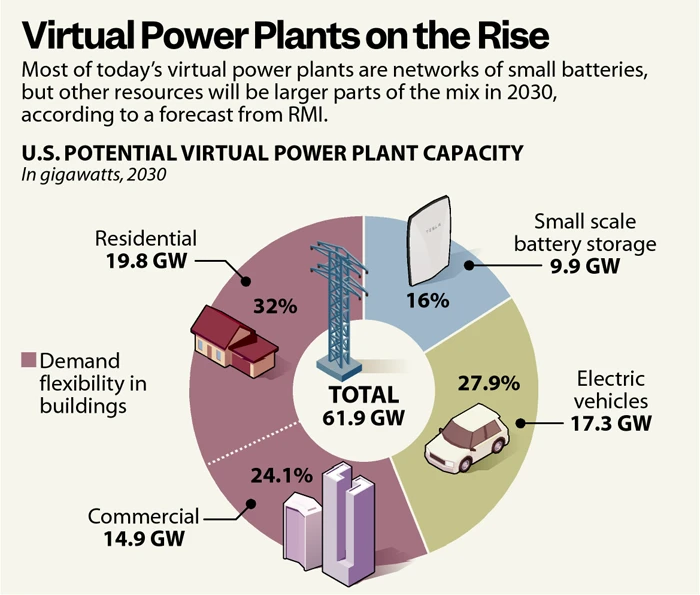In recent years, the U.S. has experienced a significant surge in electricity demand, driven largely by the proliferation of electric cars, data centers, and the increasing use of air conditioners in response to a warming climate.
This rising demand comes at a time when traditional power sources like coal, natural gas, and nuclear energy are in decline. Filling this gap, renewable sources like wind and solar farms have become more prevalent, although their output is inherently variable, dependent on weather conditions.
The Concept of Virtual Power Plants
To address the challenges of balancing supply and demand in this evolving energy landscape, power companies are increasingly turning to an innovative solution: virtual power plants (VPPs). Unlike traditional power plants that generate electricity at a single site, VPPs are decentralized networks that combine various electricity producers, consumers, and storers – known collectively as distributed energy resources (DERs). These networks can be swiftly mobilized to supply or absorb power as needed, offering a more dynamic approach to energy management.
How Virtual Power Plants Work: Understanding the Mechanism of Virtual Power Plants
Virtual Power Plants (VPPs) represent a revolutionary approach in the energy sector, moving away from traditional, centralized power generation to a more distributed and collaborative model. At its core, a VPP is a network that links various small-scale power generation, storage units, and consumption entities through cutting-edge technology.

Components of a VPP
- Small-scale Generation Units: These include renewable energy sources like rooftop solar panels and small wind turbines. Each unit contributes its generated power to the larger pool of the VPP.
- Energy Storage Systems: Home batteries and larger community-based storage facilities store excess energy generated, which can be fed back into the grid as needed.
- Electric Vehicles (EVs): EVs serve a dual-purpose in VPPs. They’re not only consumers of power but, with vehicle-to-grid technology, can act as temporary storage units, providing power back to the grid.
- Demand Response Participants: Large electricity consumers, such as factories or commercial buildings, play a crucial role. They can reduce or shift their power consumption during peak demand periods, alleviating strain on the grid.
Advanced Software and Communication Technology
The linchpin of a VPP is its sophisticated software platform that seamlessly integrates all these components. This technology allows for real-time monitoring, forecasting, and management of the distributed resources. It ensures that energy production and storage are optimally balanced with the consumption patterns and grid requirements.
Advantages of Virtual Power Plants Over Traditional Power Sources
- Rapid Deployment and Scalability: Unlike traditional power plants, which require extensive time and capital to build, VPPs can be quickly scaled up. They leverage existing infrastructure and technology, making them more agile in response to growing energy demands.
- Enhanced Resilience and Reliability: The distributed nature of VPPs means they’re less susceptible to large-scale disruptions. If one component fails or is offline, others can compensate, ensuring a more reliable power supply.
- Cost-Effectiveness: VPPs eliminate the need for significant investments in new power generation facilities. They optimize existing resources, reducing overall costs associated with energy production and infrastructure development.
- Environmental Benefits: By integrating renewable energy sources, VPPs facilitate a reduction in greenhouse gas emissions and reliance on fossil fuels. This shift to cleaner energy sources is crucial in addressing climate change.
- Improved Grid Efficiency: VPPs can balance supply and demand more effectively, reducing the need for energy wastage in the form of excess generation. This efficiency is key in managing the variable output from renewable sources like solar and wind.
- Empowering Consumers: VPPs transform consumers into active participants in the energy market. Households and businesses can contribute excess energy back to the grid, potentially earning revenue or credits.
Best Uses for Virtual Power Plants
- Peak Load Management: VPPs can be mobilized during peak demand times to alleviate pressure on the grid, either by supplying stored energy or reducing consumption.
- Integrating Renewable Energy: VPPs are ideal for integrating various renewable energy sources, managing their variability, and ensuring a steady power supply.
- Supporting Local Grids: In areas with limited infrastructure, VPPs can support local grids, providing stability and reducing the need for extensive transmission networks.
Virtual Power Plants represent a paradigm shift in how we generate, store, and consume electricity. By harnessing the power of technology and collective resource management, VPPs offer a more resilient, efficient, and environmentally friendly approach to meeting our energy needs. As we move towards a more sustainable energy future, the role of VPPs is set to become increasingly vital, but what about their growth potential?
Growth and Potential of Virtual Power Plants
The U.S. Department of Energy estimates that there are already 30 to 60 gigawatts of VPPs operational, with the potential to triple by 2030. This growth could account for roughly half of the new capacity needed to meet increasing demand and replace retiring power plants.
The proliferation of VPPs would help limit the cost of new energy infrastructure and ease the burden on aging transmission systems.
VPPs redefine the roles of electricity producers and consumers.
In traditional setups, power plants generate electricity at central locations and transmit it to consumers. The grid must always balance supply and demand, relying on a mix of baseload and flexible sources. VPPs, however, embrace the fact that consumers can control their electricity demand. Smart thermostats and water heaters, for instance, can adjust consumption based on grid conditions, effectively turning households into active participants in energy management.
Real-World Examples and Initiatives
- In Vermont, Green Mountain Power offers incentives to customers installing batteries that contribute power back to the grid during peak times.
- In Texas, utilities are using Tesla Powerwalls to transform homes into virtual power sources.
- South Australia is connecting 50,000 homes with solar and batteries to create the country's largest VPP.

Challenges and Consumer Hesitations
Despite their potential, VPPs face several challenges. Many consumers are hesitant to relinquish control of their appliances or face delays in charging electric cars. Concerns about the security and privacy of smart meters also persist. The success of VPPs hinges on the participation of consumers and the effective coordination of supply and demand by operators.
More To Discover
- Palm Oil-Based Organic Solution Can Protect Cattle from Pests Without Insecticides
- Dog First Aid: Essential Skills, Techniques, and Kit Every Dog Owner Should Know
- U.S. Offshore Wind Startup Switches To Pyramid-Mounted Turbines And It Could Be Huge
- 5 Ways You Can Help Wild Birds Survive In Every Season (Recipes Included)
In our analysis, we see the following eleven challenges and issues concerning VPPs moving forward:
- Consumer Reluctance: Many customers are hesitant to participate in programs that require relinquishing control of their home appliances or face delays in charging electric vehicles.
- Complex Management: Coordinating millions of small-scale energy resources is far more challenging than managing a few large power plants. This requires advanced, reliable technology and efficient operational management.
- Technological Dependence: VPPs rely heavily on sophisticated software and communication technologies, making them vulnerable to technological failures or cyberattacks.
- Initial Investment Costs: Setting up the infrastructure for a VPP, including smart meters and connectivity devices, can require significant upfront investment from both utilities and consumers.
- Privacy and Security Concerns: The data sharing necessary for VPP operation raises concerns about consumer privacy and the security of personal information.
- Regulatory and Policy Barriers: In many regions, regulatory frameworks haven’t kept pace with the technological advancements of VPPs, potentially hindering their implementation and integration into the existing power grid.
- Intermittency of Renewable Energy Sources: Since VPPs often rely on renewable energy sources like solar and wind, which are intermittent, this can lead to challenges in ensuring a consistent and reliable energy supply.
- Dependency on Weather Conditions: The effectiveness of VPPs can be highly dependent on weather conditions, especially when a significant portion of the energy is sourced from solar or wind power.
- Scaling Challenges: While VPPs are scalable, managing a larger network of distributed energy resources can become increasingly complex, potentially impacting efficiency and responsiveness.
- Balancing Supply and Demand: Continuously balancing supply with real-time demand in a VPP system can be complex and requires sophisticated algorithms and predictive models.
- Infrastructure Integration: Integrating VPPs with the existing power grid and transmission infrastructure can be challenging, especially in areas with outdated systems.
As the reliance on renewable resources grows and the needs of modern economies evolve, VPPs could play a crucial role in transforming the electric power industry. They offer a pathway to a more flexible, efficient, and customer-responsive system, crucial for a sustainable energy future.





















